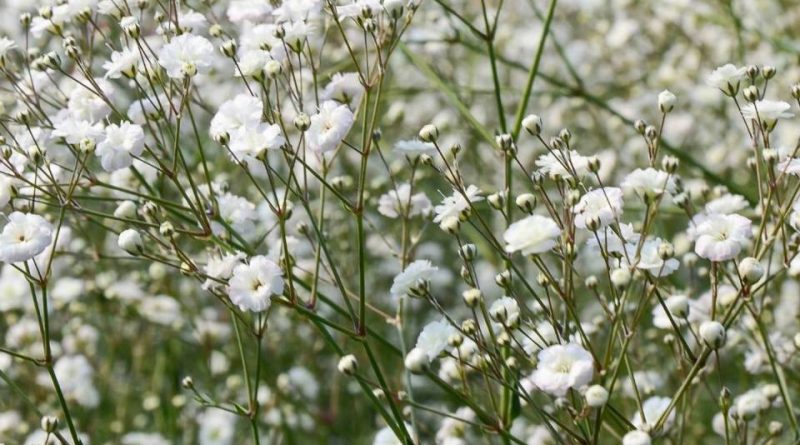Gypsophila paniculata
Gypsophila paniculata
The Baby’s breath or common gypsophila or panicled baby’s-breath (Gypsophila paniculata L.) is a perennial herbaceous species belonging to the Caryophyllaceae family.
Systematics –
From a systematic point of view it belongs to:
Eukaryota Domain,
Kingdom Plantae,
Subarign Tracheobionta,
Magnoliophyta Division,
Magnoliopsida class,
Subclass Caryophyllidae,
Order Caryophyllales,
Caryophyllaceae family,
Genus Gypsophila,
G. paniculata species.
The terms are synonymous:
– Roast pani culata Raf .;
– Gypsophila effusa Tausc;
– Gypsophila hungarica Borbás;
– Gypsophila parviflora Moench;
– Gypsophila tatarica Gueldenst .;
– Lychnis procera Ledeb .;
– Saponaria paniculata (L.) H. Neumayer;
– Silene pani culata E. H. L. Krause.
Etymology –
The term Gypsophila comes from the Greek γύψος gýpsos gesso and from φίλος phílos friend, lover: due to the habitat consisting of calcareous substrates.
The specific epithet pani culata comes from panícula panicle: with panicle inflorescences.
Geographic Distribution and Habitat –
Gypsophila paniculata is a plant found in Europe, Asia and America.
Its preferential habitat is that of dry sandy and stony places even in steppe areas.
Description –
Gypsophila paniculata is a plant with a rhizome, of rather modest size, being able to reach 0.75 m but reach up to 1.2 m in height.
The leaves are greenish gray, lanceolate and opposite two by two.
The flowers are tiny and can be single or double, white or even pink and rarely red.
Cultivation –
Gypsophila paniculata is a plant that needs sun exposure and must be kept away from rain and wind.
It is grown for ornamental use but also harvested in its natural state for local use as a medicine.
It requires a sunny position and a dry and well drained soil; the plants do not live long in humid or heavy soils and prefer calcareous soils.
Withstands temperatures down to -20 ° C.
The plant propagates by seed in spring and transplanted when the seedlings have reached a size to be handled.
It can also reproduce by division of the tufts both in spring and autumn.
Larger stems can be replanted directly into their permanent locations, although it is best to arrange them in a cold greenhouse until they root well, then transplant them in the spring.
Another way to propagate it is by basal cuttings to be taken before the flowering of the plant. In this case the shoots are collected when they are about 10 cm long with an abundant underground stem; they are then placed in individual pots and kept in light shade in a greenhouse until they take root well. The transplant must be performed in the summer.
Customs and Traditions –
Gypsophila paniculata belongs to a genus where some plants contain saponins in the root. Even if no in-depth studies have been done on this species, it is possible that it contains them. They are certainly contained in the root in the form of triterpene saponins which have spermicidal activity.
Although poisonous, saponins also have a number of medicinal applications and many saponin-rich plants are used in herbal medicine (particularly as emetics, expectorants and febrifuges) or as sources of raw materials for the pharmaceutical industry.
Saponins have a rather bitter taste and are generally poorly absorbed by the human body, so most pass through without damage. Saponins are much more toxic to many cold-blooded creatures, such as fish, and hunter tribes have traditionally placed large quantities of them in streams, lakes, etc.
This plant is best known in the ornamental field as it is used for the production of cut flowers, especially in weddings, for this reason it has the common name of bridal veil.
Preparation Method –
The Gypsophila paniculata, as well as for ornamental purposes is not of particular importance for food use, while for the medicinal one the root can be used.
Guido Bissanti
Sources
– Acta Plantarum – Flora of the Italian Regions.
– Wikipedia, the free encyclopedia.
– Useful Tropical Plants Database.
– Conti F., Abbate G., Alessandrini A., Blasi C. (ed.), 2005. An annotated checklist of the Italian vascular flora, Palombi Editore.
– Pignatti S., 1982. Flora of Italy, Edagricole, Bologna.
– Treben M., 2000. Health from the Lord’s Pharmacy, Advice and experiences with medicinal herbs, Ennsthaler Editore.
Warning: Pharmaceutical applications and alimurgical uses are indicated for informational purposes only, they do not in any way represent a medical prescription; therefore no responsibility is taken for their use for curative, aesthetic or food purposes.


